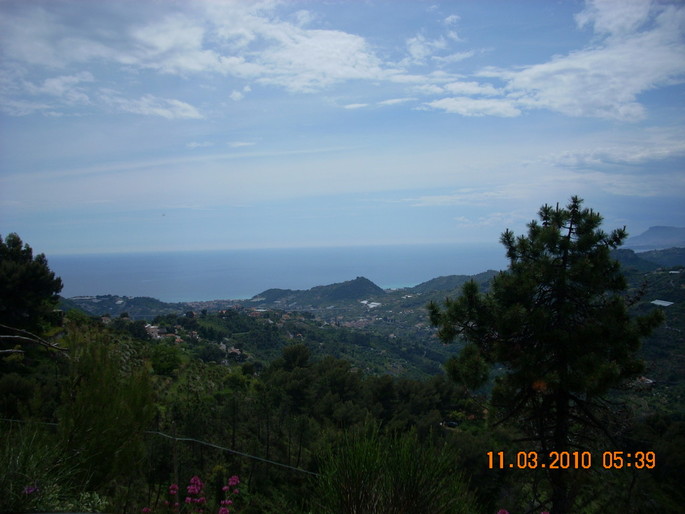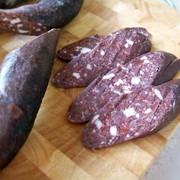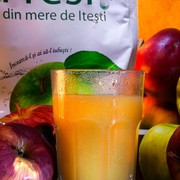The area of the Nervia valley, with the Municipalities of Rocchetta Nervina and Pigna accessible from Ventimiglia - Bordighera, is the nearest to the sea, through flower cultivations, olive groves, and vineyards giving way towards north to a characteristic mountain landscape dominated by chestnut tree, conifer, and beech tree woods.
Real jewels of this area are the rupestrian habitats of Mt. Toraggio (1,971m asl) and Mt. Pietravecchia (2,038m asl), as well as the Trans-border Nature Reserve (recently established) of Testa d'Alpe (1,517m asl).
Itinerary Gouta-Margheria dei Boschi
Mountain itinerary among the paths and military road along the forest of Testa d'Alpe, where it is possible to enjoy wonderful views of the Maritime Alps and of the Ligurian and French Coast.
Although situated a few kilometers from the sea, the Alpine zone in the surroundings of Gola di Gouta is characterized by a woody cover which is barely spread in Liguria. They are in fact silver firs and beech mixed forests, a typical of the cold mountain environments.
From the Gola di Gouta you reach the meadows of Margheria dei Boschi, then after a short stretch on a dirt road you take the mule track climbing up towards Margheria Gion (1,320 mt) and return by the old railway and a path stretch within the fir forest.
Most of the flower species can be observed from the beginning of May to the end of July. The endemic plants are: Belladonna (Atropa Belladonna), Saffron (Crocus versicolor), Dogtooth Violet (Erythronium dens-canis), Ligurian Gentiana (Gentiana Ligustica), Wild Daffodil (Narcissus pseudonarcissus), Early Purple Orchid (Orchis Mascula), Elder-flowered Orchid (Orchis Sambucina).
Silver fir forest and chalky rock walls with chasmophytic vegetation are the typical habitats.
The breeding season of the symbol animal, the roe deer "Capreolus capreolus" is in August, the male court the female by running after her across the meadows and shaping an 8. Hares' breeding season occurs in the late winter, so they give birth to the young hares in spring. In order to make the foxes' sense of smell get confused, hares walk winding trails.
Other wild animals are: the European Badger "Meles meles", the fox "Vulpes vulpes", the wild boar "Sus scrofa", the Garden Dormouse "Elyomis quercinus", among the nocturnal birds of prey you can see the Tawny Owl "Strix aluco" and the Eurasian Eagle-Owl "Bubo bubo", among the amphibians there are the Fire Salamandra "Salamandra salamandra" and the Italian Cave Salamander "Speleomantes italicus".
Gouta is 1,310 m above sea level, Margheria dei Boschi 1,100 m above sea level (Difference in height of the itinerary, outward and backward journey, about 400 m).
You reach the Gouta pass by car after the junction of the main street leading to Pigna- Castelvittorio and Provincial Road 64.
Dificulty is low.
Itinerary Melosa hill-Mount Gerbonte
The beech forest in autumn, the orchids, the lilies, the primulas and the violet in May-June, are landscape's best features.
Beech and larch forests, mountain grassland and limestone rocks are the main habitats. Other plants are: Lilium pomponium (Turban lily), Elder-flowered Orchid (Orchis sambucina), early purple orchid (Orchis mascula), Genziana ligure (Gentiana ligustica), European peony (Paeonia officinalis), cowslip (Primula veris), silver-edged primrose (Primula marginata), Limestone saxifrage (Saxifraga callosa), purple saxifrage (Saxifraga oppositifolia), long-spurred violet (Viola calcarata).
The mating period of the black grous "Tetrao tetrix" (the typical animal) - which is considered as a glacial relict in these mountains - occurs in May. The males occupy an area to carry out parades and make a wonderful and distinctive call resembling the sound of water. The females, after some days, choose the males which show to have the best skills.
Other wild animals are: the chamois "Rupicapra rupicapra", the roe deer "Capreolus capreolus", the badger "Meles meles", the fox "Vulpes vulpes", the garden dormouse "Elyomis quercinus", the European hare "Lepus europeus" and the mountain hare "Lepus timidus" Among the nocturnal birds of prey there are the tawny owl "Strix aluco" and the Eurasian eagle-owl "Bubo bubo", there are many valuable bird species, such as the rock partridge "Alectoris graeca" and the red crossbill "Loxia curvirostra". Among the amphibians it is worth mentioning the fire salamander "Salamandra salamandra", and among the reptilians the Vipera aspis and the smooth snake "Coronella austriaca".
Melosa hill (1,545 m above sea level), Mount Gerbonte (1,727 m above sea level). Difference in height during the route about 400 m between outward and backward journey.
You can reach Melosa hill by car through the provincial road 64.
Dificulty is medium-low




















